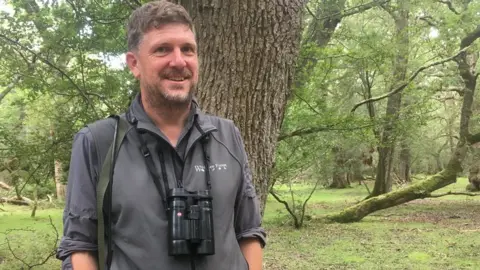Hidden cameras spot New Forest pine marten
Hidden wildlife cameras have shown evidence of a possible "established population" of pine marten in the New Forest, conservationists have said.
Pine marten were previously only thought to have survived largely in the north of England.
A new study aims to discover more about how the rare creatures have bred in the New Forest National Park.
Marcus Ward of the Wild New Forest conservation group said videos showed there were "more here than we thought".
The cat-sized member of the weasel family are notoriously elusive - sleeping and making dens high up in the trees and only coming out at night to hunt.

Mr Ward said in 600 hours of survey work he had only once caught a glimpse of one of the protected solitary mammals.
"You've got to use the technology - and understand how they use the environment and hunt to plan where to put the trail cameras.
"We maximised the chances by looking for natural routes they might take - using fallen trees that are connected."
"A lot of hours" of footage from 30 cameras dotted throughout the forest had to be checked through before any pine marten were spotted.
'Ideal habitat'
Nevertheless, he said the video results proved surprising.
"There's more here than we thought there would be - there may well be a sustainable population down here."

Forestry England's Sarah Oakley said the "minimal intervention" in managing the New Forest's ancient woodlands has helped the creatures survive.
"The woodlands support these fantastic oak trees with old rot holes, cracks and crevices which make ideal dens.
"There are large areas where the natural processes allowed to take over and that's what provides the habitat."

With no clear idea about exactly how many pine marten are currently in the forest, a team from Forestry England, The New Forest Study Group, Hampshire and Isle of Wight Wildlife Trust and Wild New Forest is set to carry out further studies into the creatures in the coming years.
Ms Oakley said the project would "build on the snapshot" of the initial video findings.
"There's a lot of local expertise about pine marten and we're sharing that knowledge with different groups around the country."
Mr Ward said: "Pine marten were native to these woods - they should be here.
"They play an important role in the ecosystem in the New Forest - we have a non-native grey squirrel population which can be damaging to the forest and pine marten would potentially help reduce those numbers."

Pine Marten

A member of the weasel family, pine marten prefer well-wooded areas with plenty of cover and largely feed on small rodents, birds, insects and fruit.
They were all but extinct from England by 1900 due to habitat loss and being hunted for their fur.
Only a small and fragmented population remains mostly in northern England, Scotland and parts of Wales.
Every pine marten is chestnut brown in colour but each has a uniquely shaped bib - a pale yellow section of fur on its chin and throat - which makes it possible to identify and record each individual.

Follow BBC South on Facebook, Twitter, or Instagram. Send your story ideas to [email protected].
